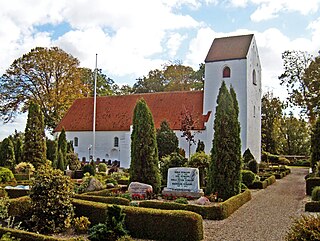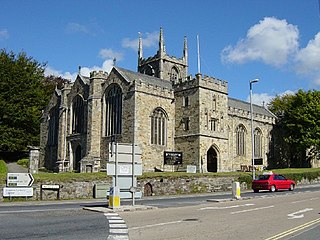History
The Augustinians
St. Peter's Priory was established about 1150 during the tenure of the Bishop of Viborg, Bishop Svend I (1106–1112), or Bishop Eskild (1112–33), his brother and successor. Bishop Svend was a strong supporter of King Valdemar I. The first recorded reference is in 1176 when the Bishop of Viborg, Niels I (1153–91), established a 'brotherhood agreement between St. Peter's and the chapter at Viborg Cathedral. St. Peter's Priory was important at the time as three 'provincials' were held at St. Peter's for all Augustinian houses in Denmark.
The location of St. Peter's was in earliest times called Salling which consisted of 'herreds' including several villages. In medieval times Salling was a political subdivision of northern Jutland called Sallingsyssel. In time the villages of Grinderslev and Breum grew on each side of St. Peter's Abbey.
St. Peter's church was built of granite blocks in the Romanesque style with rounded arches and a flat beam ceiling. An apse was built onto the choir of the church. Of particular interest is the 'priest's door' built into the side of the church with medieval carved stones on each side. Several other such carved stone can be found in the exterior of the apse. The church was towerless. The entire church is remarkably preserved. Unlike most other monastery churches, it was never rebuilt in brick; the original granite church remains with its carved granite stones. Many other early monastery churches were built in the same way and then later replaced by larger brick churches.
Augustinian canons always had a bishop at the head of their monasteries, except at St. Peter's. It is the only surviving Augustinian priory in Denmark. Bishop Niels' 'brotherhood agreement' with the chapter at St. Mary's Abbey at Viborg Cathedral is perhaps how the leadership of a bishop was implemented. The canons at St. Peter's promised to be obedient to the chapter at St. Mary's which was headed by the Bishop of Viborg. The agreement meant that the canons moved between the two houses and that the larger house at Viborg would 'protect' the smaller establishment at Salling. Augustinians were a scholarly order and operated a school, most likely for the sons of noble families in the region. In the 1440s the Augustinian Abbey at Viborg was closed and St. Peter's came under the direct control of the Bishop Thorleif Olafssön (1438–50).
St. Peter's was a small, isolated house with a thatched roof and 'very poor' according to one of the first Lutheran parish priests at Grinderslev Church. By the 15th century the church was expanded and a second aisle added in the Gothic style. Shortly after 1500 the church interior was remodelled with Gothic arches. About the same time a tower was added to the west end of the nave, but construction was poorly done, and it would have to be rebuilt in brick about a hundred years later. Even though the priory was small it owned most of the land at Salling. The farms paid rent to support the monks at the priory. Simon Nielsen was named as Prior at St. Peter's Priory in 1513.
By 1531 the Augustinians had abandoned St. Peter's. Viborg was a hotbed of Lutheran agitation against Catholic beliefs, customs, and institutions. Support for religious houses evaporated within months of the collapse of the religious centers at Viborg. The priory was secularized and given by the last Catholic Bishop of Viborg, Jörgen Friis (1521–36), to the governor (Danish: lensmand) of Skivehus Castle.
Kingdom of Denmark
In 1536 the Kingdom of Denmark became officially a Lutheran state under Christian III, an ardent Lutheran. All religious houses and their income producing properties reverted to the crown for disposal. The extensive priory archive was catalogued by the crown administrator, but subsequently lost. Only a single letter regarding St. Peter's has been preserved from 1401. In 1542 the estate was mortgaged, and then sold off in 1581 to Christoffer Lykke, a nobleman for 29 established farms, two small holdings, and two mills. The priory buildings were converted to a manor house, called Grinderslev Priory (Danish: Grinderslev Kloster), but by 1700 all of the priory was razed and the materials used to build Grinderslev Priory manor house.
Parish church
The church became the parish church for Grinderslev. The priory structures were torn down and a late Gothic brick tower, a side aisle to the nave, sacristy, and a weapons house entry were added before 1600 using materials left over from the demolition of the priory.
In 1722 the Bishop Søren Lintrop visited Grinderslev and found the priest negligent and the church and former priory buildings in serious disrepair. He ordered them to be repaired, but offered no help with the cost.
Priory site
A new manor house called Grinderslev Koster was built on the site of the priory in 1887 which can still be seen today, though it is privately owned.
Recent restoration have brought the priory church into the condition which it once had as a priory church.

St. Canute's Cathedral, also known as Odense Cathedral, is named after the Danish king Canute the Saint, otherwise Canute IV. It is a fine example of Brick Gothic architecture. The church's most visited section is the crypt where the remains of Canute and his brother Benedict are on display.

The Ancient See of Aarhus was a pre-reformation Catholic diocese in Denmark. The diocese included the counties (amter) of Aarhus and Randers, the islands of Samsø and Tunø, and, after 1396, part of the county of Viborg.

The former Diocese of Børglum was a Roman Catholic diocese in Northern Jutland, Denmark. It has also been referred to as the Diocese of Vestervig or the Bishopric of Vendsyssel. The diocese included Vendsyssel, Hanherred, Thy, and Mors.

Børglum Abbey was an important Premonstratensian abbey of medieval Denmark, located in Børglum parish, in the commune of Hjørring, approximately five kilometers east of Løkken in north central Jutland between the 12th-century until reformation.

Maribo Abbey, established in 1416, was the first Bridgettine monastery in Denmark and became one of the most important Danish abbeys of the late Middle Ages. It was located in the present town of Maribo on the island of Lolland in southern Denmark. The monastery is in ruins, but the abbey church still remains in use as Maribo Cathedral.

Vestervig Abbey, also known as Vestervig Church, was established in about 1059 making it one of Denmark's most ancient religious houses. The abbey is located at Vestervig, Thisted, in extreme northern Jutland.
Asmild Abbey was a house of Augustinian canonesses with a close connection to the Augustinian canons at Viborg Cathedral in north central Jutland, Denmark from 1165 until reformation.
Gudum Priory was a small Benedictine nunnery located in west central Jutland, Denmark from the 1260s until 1573.

Sebber Priory was a religious house located at Sebbersund, near Nibe in northcentral Jutland, Denmark. The site is now occupied by Sebber Church was well as Sebber Kloster Golf Club and Sebber Abbey manor house.

The Abbey of St Genevieve (Abbaye-Sainte-Geneviève) was a monastery in Paris. Reportedly built by Clovis, King of the Franks in 502, it became a centre of religious scholarship in the Middle Ages. It was suppressed at the time of the French Revolution.

The former Diocese of Viborg was a Roman Catholic diocese in Denmark. It was established in 1065 and was dissolved in 1536 during the Protestant Reformation.
St. Peders Kloster, later called Skovkloster, was an important early Benedictine house at Næstved, Denmark, active in 1135-1559.
Tvilum Priory was a monastery of Augustinian Canons at Tvilum near Gjern, to the north of Silkeborg, Denmark.

Halsted Priory, formerly a small Benedictine house, is a manor house and estate located close to Nakskov on the island of Lolland in southeastern Denmark. The estate was renamed Juellinge when the Barony of Juellinge was restored for Jens Juel-Vind in 1721, but its old name was restored when the barony was dissolved in 1921. Holsted Priory is still owned by the Krag-Juel-Vind-Frijs family. The Neo-Gothic main building is from 1847-49. It is flanked by Halsted Church to the north and the old main building from 1591 to the south. The old main building has been renovated with support from Realdania and is now operated as a local cultural centre. The Baroque-style park covers approximately 6.5 hectares of land. The estate is also home to a golf club.

Ringsted Abbey was one of the earliest and most influential Benedictine houses in Denmark, active from the late 11th-century until the Danish Reformation. It was located at Ringsted on the Danish island of Zealand.

Æbelholt Abbey was an Augustinian monastery situated at Tjæreby in Hillerød municipality in North Zealand, Denmark.
St. Canute's Abbey, Odense, a Benedictine monastery, was built to support the pilgrimage centre for the relics of the royal Danish martyr Saint Canute, and was the successor to the priory of St. Mary and St. Alban, Denmark's earliest monastic house. Located in Odense, it was the island of Funen's most important medieval religious institution.
St. John's Priory, Viborg, was a monastery of the Knights Hospitaller in Viborg, Denmark.

Vrejlev Priory is a former Danish priory which dates back to the 13th century. The priory located at Vrejlev, near Vrå, Region Nordjylland, Denmark. Between 1165 and the Protestant Reformation, it was operated as a Premonstratensian nunnery.

St Petroc's Church, Bodmin, also known as Bodmin Parish Church, is an Anglican parish church in the town of Bodmin, Cornwall, England, United Kingdom.













